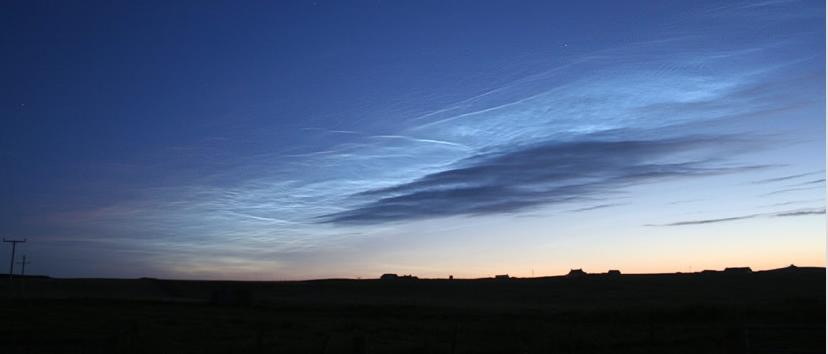Noctilucent Clouds, NLCs
Noctilucent Clouds: A Spectacular Sight in the Summer Sky
Noctilucent clouds, also known as NLCs or "night shining" clouds, are a mesmerizing atmospheric phenomenon that can be observed during the short summer nights of latitudes between 50 and 65 degrees. These ethereal clouds are Earth's highest, located approximately 50 miles above the surface and near the extremely cold mesopause. Their unique characteristics and elusive nature make them a captivating subject for sky enthusiasts and photographers alike.
When it comes to appearance, noctilucent clouds can range from colorless to bluish-white. Their structure is often intricate, resembling skein-like formations with undulations, corrugations, knots, and streaks that extend upwards into the sky. However, at times they can also appear as featureless bands close to the horizon. This variability adds to their allure and makes each sighting a unique experience.
One of the remarkable aspects of noctilucent clouds is their seasonality. These clouds are typically visible from mid-May to mid-August in the Northern Hemisphere, while in the Southern Hemisphere, they can be observed from mid-November to mid-February. It is important to note that they are never visible during daylight hours. To catch a glimpse of these elusive clouds, it is best to wait until about an hour after sunset when twilight has deepened. At this time, the sun should be positioned 6 to 16 degrees below the horizon, darkening the sky but still providing enough sunlight for the NLCs to be illuminated.
To increase your chances of spotting noctilucent clouds, it is recommended to search low in the sky towards the direction of the sun beneath the horizon. Before midnight, they can be found towards the northwest, while after midnight, they tend to appear in the northeast. However, it is important to avoid nights with a bright moon, as the lower clouds and cirrus clouds can be lit up against a darker sky, making it difficult to distinguish the NLCs.
Binoculars can be a useful tool for observing noctilucent clouds, as they allow for closer inspection and sharper details. By magnifying the clouds, it becomes easier to differentiate them from lower cirrus clouds, which may appear similar to the naked eye. However, it is important to note that binoculars are not necessary to appreciate the beauty of these high-altitude clouds.
Noctilucent clouds are predominantly observed in the higher latitudes of the Northern Hemisphere. However, sightings have been reported further south as well. In Europe, they have been seen as far south as Austria, Hungary, Italy, and southern Germany. In the United States, Utah and Colorado have also witnessed these captivating clouds. The ability to observe NLCs in these regions adds to the global fascination with this atmospheric phenomenon.
In conclusion, noctilucent clouds are a captivating sight in the summer sky, offering a glimpse into the mesmerizing beauty of Earth's highest clouds. Their seasonal nature, intricate formations, and elusive behavior make them a sought-after subject for sky enthusiasts. By following the recommended observation techniques and being patient, you may be fortunate enough to witness these ethereal clouds and create lasting memories of their awe-inspiring presence in the nocturnal heavens.

Night shining clouds imaged 1:30am July 2007 by Anne Hourston in the Scottish Orkney Islands. They are Earth's highest clouds, 50 miles high and close to the immensely cold mesopause. They are in summer sunlight while the dark tropospheric clouds a mere 1-3 miles high are in night. ©Ann Hourston, shown with permission.
The short summer nights of latitudes of 50 - 65° reveal the highest clouds - noctilucent or ‘night shining’ clouds, NLCs.
They are colourless or bluish-white. They can be skein-like, rich with undulations, currugations, knots and streaks clawing upwards into the sky, at other times they lie close to the horizon as a featureless band.

The clouds are seasonal. Look for them from mid May to mid August (mid-November to mid-february in the Southern Hemisphere). They are never visible in daylight. Wait until an hour after sunset when twilight has deepened. The sun should be 6 - 16° below the horizon, enough to darken the sky but not so low that the NLCs are not still in sunlight. Search first of all low in the sky towards the direction of the sun beneath the horizon, northwest before midnight, northeast afterwards. Avoid moonlit nights when lower clouds and especially cirrus are lit white against a darker sky.
Binoculars help in distinguishing them from lower cirrus clouds because under magnification they appear sharper.
NLCs are seen further south. They have been sighted in Europe as far south as Austria, Hungary, Italy and southern Germany. In the US they have been seen in Utah and Colorado.
Note: this article has been automatically converted from the old site and may not appear as intended. You can find the original article here.
Reference Atmospheric Optics
If you use any of the definitions, information, or data presented on Atmospheric Optics, please copy the link or reference below to properly credit us as the reference source. Thank you!
-
<a href="https://atoptics.co.uk/blog/noctilucent-clouds-nlcs/">Noctilucent Clouds, NLCs</a>
-
"Noctilucent Clouds, NLCs". Atmospheric Optics. Accessed on December 21, 2024. https://atoptics.co.uk/blog/noctilucent-clouds-nlcs/.
-
"Noctilucent Clouds, NLCs". Atmospheric Optics, https://atoptics.co.uk/blog/noctilucent-clouds-nlcs/. Accessed 21 December, 2024
-
Noctilucent Clouds, NLCs. Atmospheric Optics. Retrieved from https://atoptics.co.uk/blog/noctilucent-clouds-nlcs/.